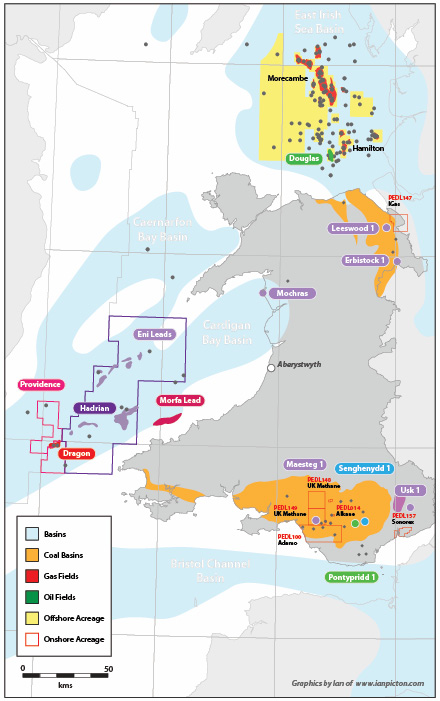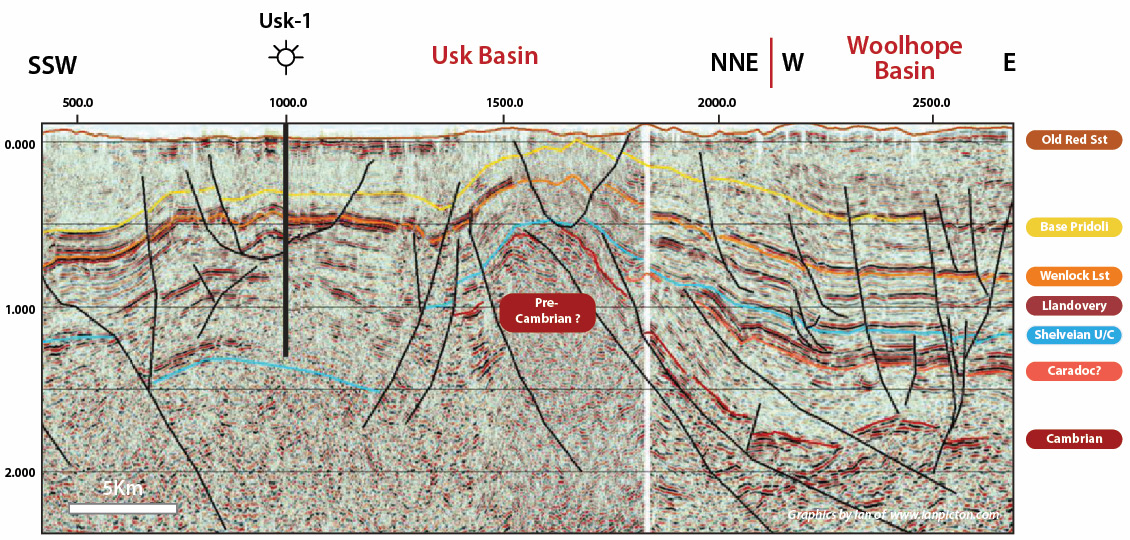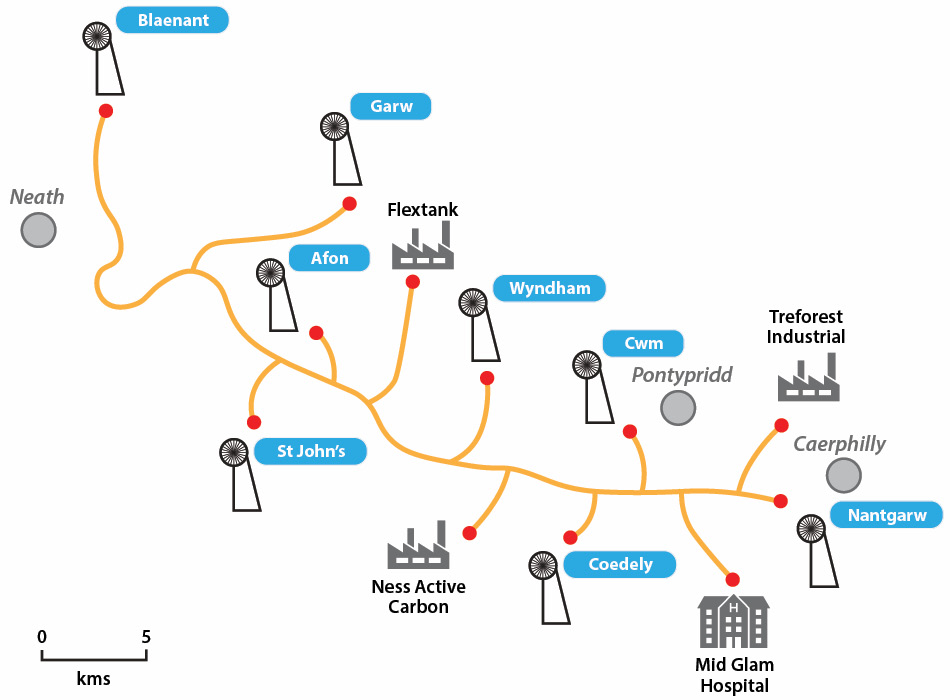Broadly, the offshore of Wales contains parts of six main Permo-Mesozoic basins which are the East Irish Sea, Caernarvon Bay, Cardigan Bay, St George’s Channel, Celtic Sea and Bristol Channel. The onshore consists of slivers of the Permo-Mesozoic Cheshire Basin and Worcester Graben in Mid and Central Wales, and in the south, it is dominated by the Devonian–Carboniferous South Wales Coalfield Basin and the Silurian Usk Basin.
Early Onshore Exploration
It is not commonly known but the oil and gas industry began in Wales in the 1860s in Flintshire in North Wales. There is a fascinating account of a seam of Carboniferous-aged cannel coal (or candle coal), a type of bituminous coal also classified as an oil-shale, being worked in the Leeswood Green Colliery, near Mold in North Wales. According to Giffard (1938) the cannel coal was used chiefly for the manufacture of ‘illuminating oil’ by distillation of the coal in cast-iron retorts at a low red heat. Lubricating oil and grease were also obtained. At the time the largest of the 20 or so coal-oil companies was the Flintshire Oil & Cannel Co. Ltd. However, the ‘oil boom’ was short-lived with cheap exports of oil coming from Pennsylvania leading to the bankruptcy of most coal-oil businesses in North Wales by the 1870s. In the current era this would have been classified as unconventional oil exploration and production.
The first well drilled in Wales targeting conventional oil and gas was Pontypridd-1, drilled in Licence 114 in South Wales in 1941 by Anglo-American, a company which later became part of Esso. The shallow exploration well, located without seismic data and on surface geology, targeted Carboniferous-aged Millstone Grit and Basal Grit as part of a wartime effort to find oil for Great Britain. Figure 1 shows a location of the wells drilled in Wales. It reached a total depth (TD) of 1,973 ft but no hydrocarbons of significance were reported. Pontypridd-1 took some nine months to drill and was no doubt a stop-start process due to the situation at the time. The licence was relinquished in 1947. The drilling of Pontypridd-1 was probably in response to the D’Arcy Exploration Company (later renamed The British Petroleum Company) discoveries in the Carboniferous succession at Eakring (1939) and Kelham Hills (1941) in Nottinghamshire.
The second well drilled in Wales was Leeswood-1, drilled by D’Arcy in 1955 in Licence A100. D’Arcy had likely been encouraged by reports of the coal-oil in the Flintshire mines. The shallow well targeted the Carboniferous Limestone and Millstone Grit at a location near the River Alyn. The well reached a TD of 1,093 ft in around six weeks with no hydrocarbon indications. Plans to drill a follow up well on the Billberry Wood Prospect to test the same objectives were then scrapped by the operator.
In the early 1960s a Conoco and Marathon-led group (Envoy and Safari were involved in some of the licences) was awarded acreage covering parts of Carmarthenshire, Glamorgan, Radnorshire, Monmouthshire and Brecon, and adjacent Welsh borderland counties. Trevor Thomas, in a publication in 1964, speculated that the group was optimistic of a Silurian source rock. The major Silurian source rocks discovered in the Middle East, North Africa, and the USA, may have driven these exploration efforts.
Between 1967 and 1969 an important geological discovery was made at the Mochras (or Llanbedr) borehole on the coast of Gwynedd, West Wales. The stratigraphic well was drilled on the edge of Cardigan Bay by the Institute of Geological Sciences, now the British Geological Survey (BGS), and encountered a thick succession of Jurassic rocks. The unexpected outcome of the borehole brought into play the Mesozoic hydrocarbon potential of the Cardigan Bay Basin, and a major re-think of the geology of Wales.
In 1972 Cambrian Exploration Ltd spudded the Senghenydd-1 exploration well in PL155 in South Wales. The well reached a TD of 9,331 ft in the Middle Silurian without encountering significant hydrocarbons in likely Carboniferous and Devonian sandstone objectives. Cambrian followed this up with Maesteg-1 in 1973 in adjacent PL154. The well seems to have targeted Devonian and Ordovician sandstones, reaching a TD of 8,690 ft in Ordovician sediments. There are again no reports of any significant hydrocarbons and the licences expired in 1978 without further drilling in Wales.
From the early 1970s attention moved to the North Sea, but BP continued to explore onshore and drilled the Erbistock-1 wildcat in 1986 in PL228. The licence was located near Overton Bridge, south of Wrexham, near the England border. Erbistock-1 was deviated and designed to test Carboniferous-aged Westphalian and Namurian sandstones, and the Dinantian dolomites on the western edge of the Cheshire Basin. BP had been encouraged by oil shows in the area; however, only poor hydrocarbon shows were reported in the Dinantian, which turned out to be sandstones rather than the anticipated shelf limestone and dolomite. It reached a TD of 6,196 ft.
In late 1988 Sovereign Oil Ltd, a successful offshore UK explorer at the time, spudded the eagerly awaited Usk-1 wildcat in EXL080 in the Usk Basin in south-east Wales. Sovereign had some heavyweight partners that included Union Texas and Amerada Hess. The well, located east of the north–south-orientated Usk Anticline, was designed to target Silurian sandstones but encountered weak gas shows only (Figure 2).
Usk-1 reached a TD of 10,040 ft in the Lower Silurian, and remains the last conventional oil and gas exploration well drilled onshore Wales. While disappointing, it did demonstrate the potential of a Silurian or older source rock with the gas shows encountered. A single Drill Stem Test (DST) conducted between 5,644 and 5,810 ft recovered mud filtrate and formation water only.
Gas from Coal
For several decades, the National Coal Board (NCB) had been involved in the draining of methane for safety reasons from active mines, but in addition it was a valuable clean fuel and used commercially. Mine gas only has medium heating value and was uneconomic to transport too far from the point of production. Morgan (1974) reported that initial trials were conducted in South Wales in 1950 and commissioning of a South Wales Methane Grid took place in 1957.
In 1956 the Wales Gas Board and the NCB agreed to a 20-year contract for the supply of methane from the Point of Ayr Colliery in North Wales for use in the national grid. It seems that a similar joint venture was in place to supply methane from local mines to the Aberavon gas works in South Wales. The NCB had a methane gas grid of around 80 km of pipeline in the South Wales Coalfield, with the Afán colliery near Port Talbot used as underground storage.
In 1983 around 17 Bcf of pure methane is reported to have been drained from coal mining operations in the UK, with some 1.5 Bcf coming from South Wales. At the time the NCB reported that the South Wales network of pipelines was used to integrate the supply of coke oven gas and mine gas. These customers included Treforest Industrial Estate, Mid Glamorgan Hospital, Flextank (later known as Thompson Technik) and Ness Active Carbon Plant (Figure 3).
From the mid-1990s, following success in places like the USA, Australia, and China, several Coal Bed Methane (CBM) and Mine Gas licences were applied for and awarded, with some 17 shallow wells drilled. These are split into four CBM wells in South Wales and three in North Wales, and eight Mine Gas wells in South Wales plus two in the North, none of which have proved particularly successful according to public data. More recently, old coal operations have made the news with an announcement that the UK is in an exploratory stage with its mine water heat schemes. The UK Geoenergy Observatory (UKGEOS), based in Glasgow and run by the BGS, is one of the key research stations.
The Move Offshore
The first offshore well in Welsh waters was 103/21-1 drilled by Amoco in 1971. The wildcat was drilled to test potential Lower Cretaceous, Jurassic, Triassic, and Permian sandstone reservoirs in a poorly understood area in the South Celtic Sea Basin. However, the well failed to produce any encouragement.
By the mid-1970s, exploration in the North Sea had really taken off with success after success. The enthusiasm also spread to other basins in UK waters and from 1973 to 1978, nine exploration wells were drilled in Welsh waters by major companies including operators Deminex, Shell, Arco, Arpet, Conoco, Texaco and Hydrocarbons Great Britain (HGB).
While these wells in the Liverpool Bay area of the East Irish Sea Basin (HGB) were unsuccessful, a subsidiary of British Gas discovered the world-class 5 Tcf South Morecambe gas field in 1974. The significant discovery was made shortly after the surrender of the block in rather unusual circumstances by Gulf Oil. Gas was discovered in the upper part of the Lower Triassic Sherwood Sandstone Group.
Finally Offshore Success
The offshore area saw another burst of activity starting in 1989, and in 1990 Colorado-based Hamilton Oil discovered the Douglas oil field with well 110/13-2. The field is located some 24 km off the coast of North Wales in 28m of water. The wildcat had been designed to test a gas play following the success at South Morecambe, and the discovery nearby of the Hamilton and Hamilton North gas fields. Oil tested at the rate of 1,800 bopd of 44-degree API oil from the Triassic Sherwood Sandstone with the Carboniferous Namurian Bowland Shale Formation believed to represent the source rock. The Douglas field came on stream in 1996 and was the first oil field developed in the East Irish Sea and Wales’s first and only oil production to date. At the time of discovery, the field was estimated to contain over 200 million barrels of oil in place.
By 2020 the field had impressively produced over 100 million barrels. The Douglas oil field is now operated by Eni after its acquisition of BHP Petroleum’s East Irish Sea assets in 2014. The field was developed with 22 wells: 15 producers, six water injectors and a single sour gas and condensate disposal well.
In 1994 Marathon Oil made the 103/01-1 gas discovery (later named Dragon) in 96m of water in the St George’s Channel Basin, some 40 km off the south-east coast of Ireland and 35 km off the coast of Wales. Marathon was awarded Block 103/1 in the UK 14th Round of Licensing in May 1993. Well 103/01-1 was drilled to test a Triassic Sherwood Sandstone prospect as well as a secondary Jurassic Bajocian objective. Due to drilling problems the Sherwood Sandstone was not reached, and the secondary target of the Bajocian Sandstone was absent due to faulting. However, hydrocarbons were found in Jurassic sandstones of Callovian to Oxfordian age. The well tested at the rate of 21 MMscfg and 120 bopd of 42-degree API oil. The source of the hydrocarbons are Carboniferous shales and coals.
At the time it was estimated that the Dragon field had gas in place of around 120 Bcf. Marathon undertook a 3D seismic survey in 1995 and a fault block up-dip of 103/01-1 was identified as a potential large structural trap. A drilling moratorium prevented the appraisal of Dragon until 2005. The deviated well 103/01-2 was drilled in 2005 by Marathon but sadly the sands proved to lack hydrocarbons and reserves in the field were downgraded to around 50 Bcf.
In 2007, Ireland-based Providence Resources was awarded a Standard Exploration Licence covering Irish Block 51/01 and began discussions with Marathon regarding potential development of the fault block drilled by the 103/01-1 well. Marathon’s UK licence became listed as fallow and was subsequently relinquished in 2010 based on lack of commerciality. Providence submitted an out-of-round application for the block and were awarded the licence in January 2012 with its then partner Star Energy Oil & Gas Ltd. The structure of the Dragon gas field straddles the Ireland/UK median line which was attractive to the partnership. Providence subsequently relinquished the Dragon field in 2016 as it was deemed uncommercial. The field is now in open acreage and with the pending energy shortage it could be time for another company to revisit the field.
The last exploration well drilled offshore Wales was 110/13b-21. The well was drilled by BHP, with Eni as a partner, on the Bel Air Prospect close to the Douglas field in 2010. This well is reported to have encountered a thicker than expected Permian-aged Manchester Marl sequence comprising interbedded shale and dolomite. However, hydrocarbons were absent in the well. The primary objective was Permian Collyhurst Sandstone in large fault block structure.
Today
Since 1 October 2018, Welsh Ministers are responsible for licensing the exploration and development of Wales’s onshore petroleum resources. They have a statutory duty to manage the existing petroleum licences that were issued by the UK Government before 1 October 2018. As the licensing authority, Welsh Ministers are responsible for decisions on whether to issue new licences and the management of existing licences issued before 1 October 2018 in accordance with the licence model clauses.
The offshore is still the responsibility of the UK Government. Other than the area around the Douglas oil field in the Irish Sea, there are no current offshore licences in Welsh waters. With proven hydrocarbons, it is hoped that the open areas in the St George’s Channel Basin will attract industry interest in the future. It is hard to conclude that Dragon is the only hydrocarbon accumulation in Welsh waters in the basin.
Potential plays exist in the Cardigan Bay Basin where the Lias and Carboniferous offer possible source rocks, but the challenge is getting the correct configuration of source rock, trap and reservoir. One such feature that may bring all these together is the Morfa Structure, a rollover anticline alongside the east north-east to west south-west Bala Fault. The location is shown on Figure 1.
The potential of these two basins was demonstrated by the award of 17 blocks to Eni in the 28th Offshore Licensing Round in 2015. Eni had planned a 955 sq km 3D survey to firm up several leads, named after Roman emperors and mapped to prospect status. The leads are shown in Figure 1 which are taken from an Eni relinquishment report available via the OGA’s open data site. Eni’s largest lead is designated Hadrian and covers parts of Blocks 106/24,25 and 29, alongside the north-east to south-west St George’s Fault. Hadrian has Jurassic and Triassic sandstone objectives and Eni estimated its recoverable reserves at around 40 million barrels of oil and 300 Bcf of gas. However, due to environmental issues the 3D survey was cancelled, and Eni subsequently relinquished the blocks in 2019.
There are currently five unconventional and only one remaining onshore conventional licence, which is held by UK-based Sonorex Oil & Gas Ltd. The full list of all current licences is listed below.
It is worth noting that although the work programmes associated with each licence are broadly categorised as conventional/unconventional, the licensee is not contractually bound to deploy any specific techniques. In practice, the developer can modify plans as their understanding of the geology improves.
PEDL157 is now held until 2035 by Sonorex and it is intended to drill the Uskmouth-1 well. Sonorex acquired 28 km of new 2D regional seismic data in 2006.
The Uskmouth Prospect has a Devonian Old Red Sandstone primary objective and Silurian Wenlock sandstones offering a secondary target, with charge coming from Silurian or older shales. The overlying Carboniferous will provide the seal. The exploration well will be designed to simultaneously test for hydrocarbons, geothermal and Carbon Capture Storage (CCS) capabilities with a planned TD of 4,000 ft. The Silurian shales also offer an unconventional target. Sonorex estimate resource size to be in the range of 200 Bcf of gas. In 2000 there were reports of gas leaking into houses in the Ringland area of Newport which perhaps offers encouragement to Sonorex of an active petroleum system.
Acknowledgements
Many thanks to Ian Picton, Malcolm Butler, Andy Butler, David M Thomas, Lyndon J West, Huw Evans, and Chris Atkinson.










